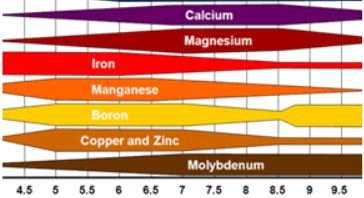
Teagasc Crop Report
Trace Elements
Trace Elements

To view the full report you must have an existing account with Teagasc ConnectEd.
Farmers sign in hereAlready have a ConnectEd account? Connected Client or Teagasc staff log in here
Trace Elements
Trace Elements are critical for healthy plant growth. Crops lacking in trace elements will experience stunted growth, poorer disease resistance and lower yields.
Copper
Copper has a major function in grain / ear fertility and deficiency symptoms can go unnoticed and result in a yield reduction. Cereal crops will take of in the region of 80grams/ha of copper. Copper deficiency symptoms can go unnoticed; symptoms associated with a server deficiency are leaf twisting and white leaf tipping and tend to appear in the youngest leaf. Copper deficiency may be due to low soil availability or low total soil copper and is problematic on light, acidic soils, low soil organic matter, granite parent materials and dry soil conditions. Cereal crops grown on soils with <3 mg/l will require a foliar copper application.
Manganese
Manganese deficiency is one of the most widespread deficiencies in cereals, especially at high pH or with recently limed soils. Yield responses to Mn are found with cereals growing in soils of pH 7 or more when the easily reducible Mn level in soil test falls below 50 mg/l. Soil analysis (easily reducible manganese) is an indicator to soil Mn availability, however, this is not fully reliable for predicting the occurrence of Mn deficiency. Leaf analysis is more reliable than soil analysis for diagnosis of possible Mn deficiencies.
Transitory Mn deficiency can also occur as a result of the conversion of Mn++, the plant available form that is found in the soil solution, to manganese oxides and hydroxides which are unavailable to plants, a process that occurs when it comes in contact with oxygen and is more likely during periods of drying weather conditions or low soil moisture levels. Conditions which increase the amount of air in the soil such as loose seedbeds or dry soils can induce manganese deficiency. Seedbed consolidation plays an important role in increasing Mn availability by increasing root to soil contact and reducing Mn oxidation. Manganese deficiency that occurs as a result of dry soils will often be corrected by rainfall.
Manganese deficiency is controlled by the application of foliar sprays of Mn compounds with manganese sulphate (this requires high water volumes and check mix / product compatibility). Application should be repeated if the symptoms persist. Chelates and inorganic compounds of Mn are also effective and needs to be applied once a Mn deficiency is identified, as early detection will reduce crop yield loss. These have the added advantage of being applied in lower volumes of water, and compatible with certain fungicide and other pesticides. Manganese treated seed is an option to get Mn into the root zone and early in plants development. This is the most effective method to eliminating or reducing manganese deficiency. Fertilisers containing Mn can be in effective as once the fertiliser is applied to the soil the availability of the Mn is reduce as it becomes locked up in the soil nutrient complexes and plant availability reduced. In addition the applications of manganese sulphate to the soil are not effective in correcting deficiencies in the long term. See table 1 below for information on copper and zinc.
Zinc
Zinc has a major role to play in fertility, seed formation, plant growth and defence against diseases. A cereal crop will remove in the region of 200 grams/ha annually. Zinc deficiency is a major problem is many parts of the cereal growing areas in Ireland. Zinc deficiency is problematic on continuous tillage soils and soils with elevated levels of soil phosphorus. Plant symptoms are very distinctive, in cereals zinc deficiency generally shows up in the early stages of growth, when the plant is only a few inches high, appearing first as yellow streaks in the young leaves with a white to yellowish tip. White spots often appear in the leaves or along the edges and a portion of the marginal area my die. Frequently the entire plant is stunted, due to shortening of the internodes. Cereal crops grown on soils with <2 mg/l will require a foliar zinc application.
Treating Trace element Deficiencies:-
There is a wide range of trace element products available see trace element appendix for details. Generally all available products applied as per product recommendation (check product compatibility with other agri – chemicals) will meet crop seasonal requirements. More importantly is early identification and treatment of a trace element deficiency. This is essential to reduce any reduction in grain yield therefore a little and often approach is often best
There is a large variation of soil types across Ireland. The Irish Soil Information System will help to identify areas of the country where soils are low or high in soil trace elements.
Please create an account to view hidden content